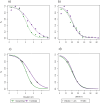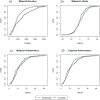A biogeographic comparison of two convergent bird families
- PMID: 41134757
- PMCID: PMC12551894
- DOI: 10.1371/journal.pone.0335195
A biogeographic comparison of two convergent bird families
Abstract
Convergence between species and entire clades can occur due to shared environmental conditions and shared resource use. Comparisons of biogeography between convergent clades and taxa may reveal some of these properties unique to each taxon. We sought to characterize and compare the global scale biogeography of hummingbirds (family Trochilidae), which possess unique adaptations for nectar feeding, with sunbirds (family Nectariniidae), which also feed on nectar but are more generalist in their feeding ecology. We collected the latitudinal and elevational range of all species in both clades to create species distributions along those gradients by way of empirical cumulative distribution functions. We compared those distributions to see 1) if they differed, by way of minimum difference estimation and 2) how they differed, by way of non-linear regression. Hummingbirds are shown to extend into higher elevations and latitudes compared to sunbirds, and better maintain their species number in these more extreme environments. We provide possible reasons for these patterns including dispersal limitation, land area, diversity of resources, and climatic conditions. In one particularly interesting hypothesis, we propose that hummingbirds' unique adaptations for nectar feeding allow them to exploit resources more efficiently, gain higher intrinsic fitness, and therefore speciate and spread into more extreme climates than less efficient nectar feeding sunbirds.
Copyright: © 2025 Halloway et al. This is an open access article distributed under the terms of the Creative Commons Attribution License, which permits unrestricted use, distribution, and reproduction in any medium, provided the original author and source are credited.
Conflict of interest statement
The authors have declared that no competing interests exist.
Figures




References
-
- Cody ML. Character convergence. Annu Rev Ecol Syst. 1973;4:189–211.
-
- Mosauer W. Adaptive Convergence in the Sand Reptiles of the Sahara and of California: A Study in Structure and Behavior. Copeia. 1932;1932(2):72. doi: 10.2307/1435888 - DOI
Publication types
MeSH terms
LinkOut - more resources
Full Text Sources

